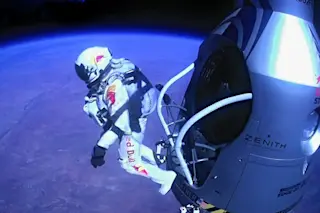Last October more than 8 million people watched on YouTube as Austrian daredevil Felix Baumgartner jumped from a balloon 24 miles above the ground. During a 4 minute 20 second free fall, he became the first person to break the sound barrier without a plane. He also broke the record for highest skydive, set by his mentor, former test pilot Joseph Kittinger. In 1959 and 1960, when the Air Force was testing ejection seat technology in jet fighters, Kittinger made three jumps from the stratosphere to try a parachute optimized for high-altitude bail-outs.
There are no ejection seats in the space planes being built by private companies like Virgin Galactic, but that may change now due to innovations developed for the extreme jump. Skydiver Luke Aikins, the designer of Baumgartner’s parachute system, says the most important technology he tested was an automatic rip cord that deploys if it senses that the jumper has entered a sustained high-G spin. “You could give this to an astronaut and save their life,” Aikins says. “It reduces the threat of a redout, which is basically a stroke, in free fall.”
In theory, there is no limit to how far high-jump technology could go. In the 1960s General Electric worked on a parachute and heat-shield combo called MOOSE (Man Out of Space, Easiest) that would allow a bail-out from orbit. The idea never went anywhere, but someone—maybe one of those millions who watched Baumgartner—will inevitably dust off the concept and make a fiery reentry into Earth’s atmosphere without the protection of a spaceship.














